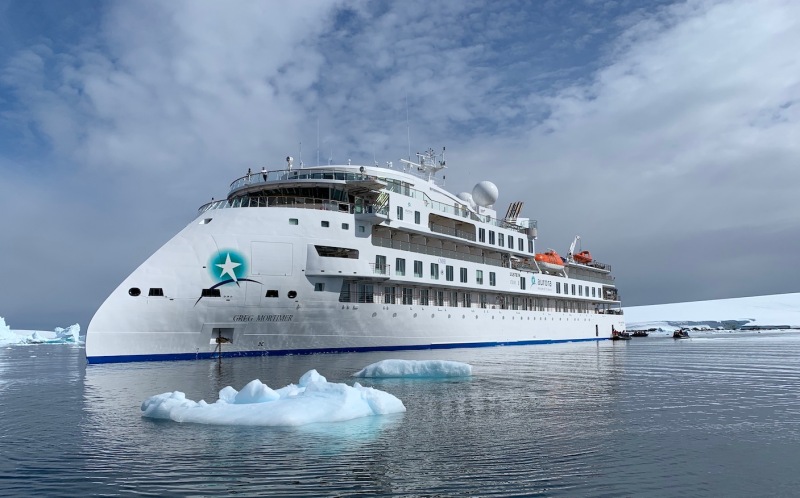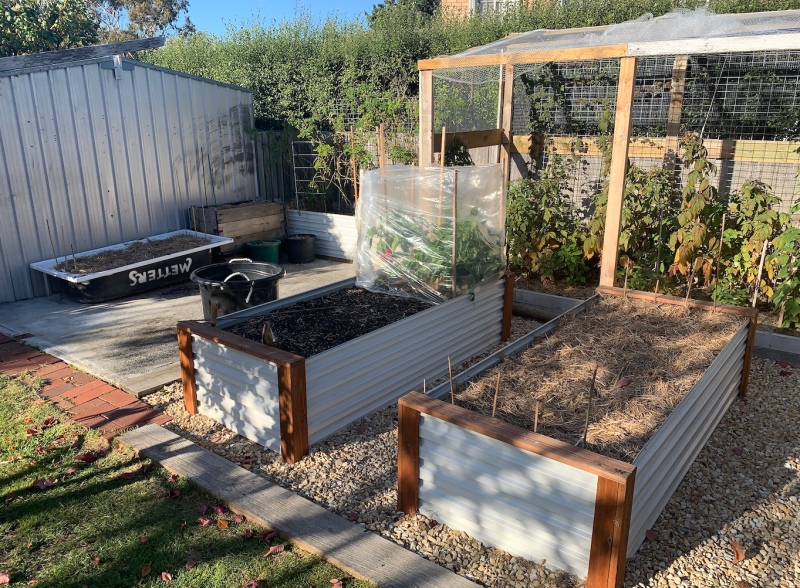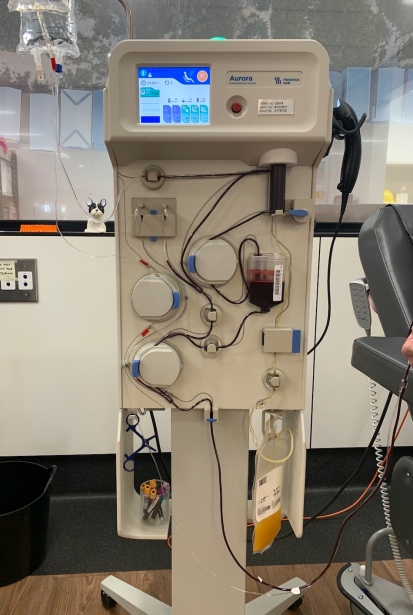I am officially an Australian Detainee, partway through a second round of hotel quarantine. Twenty-eight days to make sense of a voyage to Antarctica and South Georgia that wasn’t, except for five halcyon days exploring the Antarctic Peninsula. Innocents were we in that realm of ice and wilderness, to the maelstrom ahead.
BEFORE
Listen. Listen. Heed your intuition.
MV Greg Mortimer steams away from the port of Ushuaia in Tierra Del Fuego, four days after the World Health Organisation ‘characterises’ Covid-19 as a pandemic. Covid has shaped itself into a character, wreaking havoc through its own dystopian novel.
This is my 23rd year of working in the polar regions north and south. I live a blessed life, astonished that as I grow older, opportunities have increased rather than diminished. I work hard. I believe I am good at what I do. In the week before leaving home, Covid consumes the ABC News, The 7:30 Report; Dr Norman Swan’s steadfast bats a louder, longer volley of science and statistics. I try to recall the very first news mention of a Wuhan ‘seafood’ market, as it was in that first iteration, where a group of workers presented with lethal flu-like symptoms. I remember less about the words than the prickling that charged across my skin.
The plight of Diamond Princess is all across the news. I think to my voyage ahead. I do not want to contract the virus, but my anxiety lies more in being stranded, unable to get back home. On advice from a friend I head to my GP in those final days at home for a precautionary pneumococcal vaccination. Dr Sarah asks about the ship work, how I’m feeling. ‘Do you have to go?’ she speaks to my unhappiness. ‘If I don’t,’ I answer, ‘I’ll be forcing someone else to take my place.’ That is one truth. The noble truth. I love what I do. I also need to earn the income. And if I forfeit my contract so close to departure, never mind my track record, chances are I will not be asked to work again.
Off I go.
Life eases on arrival in Ushuaia, el fin del mundo as the town prides itself, a picturesque southerly port that in my two decades of coming here has expanded seven-fold on the shoulders of Antarctic tourism. In this once-frontier-now-overpriced-tourist town, the air feels crisp and clean. Remnant snow clings to the surround of peaks. It is a beautiful place. I walk along the foreshore soaking up the southerly air. Familiar territory. The start of any happy voyage.

Sunrise over Ushuaia and the Beagle Channel, embarkation day, 15 March 2020
On embarkation day our outgoing ship’s doctors visit hotels to ensure the good health of our incoming passengers, taking temperatures, checking for flu-like symptoms, scouring the relevant travel history of each person who boards the ship. Would-be passengers from high-risk regions have already been declined from joining the voyage. Ninety Australian passengers, 12 New Zealanders, 12 from across the UK, Europe and USA. The expedition team makes up a further eighteen, with Florence as Expedition Leader, me as Deputy Leader. The ship’s crew, 85, are from all over, many from the Philippines. We are a small expedition ship. A low risk group of travellers. We are nothing like Diamond Princess. Why, then, when I step aboard does it feel like a game of Russian Roulette?

Lifeboat and safety drill is a maritime requirement before leaving dock
As we ease away from the dock, I would like to remember a bubbly, happy ship, raring to go. But we are not. Not entirely. Several passengers express fear and anxiety. I listen. I am careful not to say, everything will be okay. I do not say, we will be just fine. I visit one couple whose outright rage stems from feeling trapped. They do not want the voyage to proceed. What if I had said to them, Heed your intuition. Go home. Go home.
Others onboard sparkle with the thrill of a trip of a lifetime. Antarctic Peninsula, Elephant Island, South Georgia, the Falklands. We are on our way, east along the cold waters of the Beagle Channel, seabirds skimming by. Argentina to our portside, Chile to our starboard.
We pass the distinctive silhouette of Mount Olivia which each time brings to mind a junior passenger from long ago. Your mountain, young Olivia. The road gives way to tracks. Tracks merge into forests of beech. It turns midnight when the first roll of ocean lifts our keel. We forge out to open sea.
DURING
a cage is a cage
Day 2: 16 March 2020: New Zealand announces that its flagship airline will suspend long-haul flights from the end of March. A whisper comes down the line: Ushuaia may soon be set to close its doors. The inevitable penny drops sharp and shrill. The ship quavers with an image of one then the next airline shutting down, borders snapping shut. The company heeds our grave concerns. But Ushuaia closes its borders and we can no longer simply turn around. A decision is made to shorten the voyage. We must do our time at sea, our own personal quarantine.
Day 3–7: 17–21 March: Arrangements are underway for an end-of-month charter flight from Stanley in the Falkland Islands, the lag of days between now and then ensuring we can safely dock and pose no risk, confident in everybody’s eyes that we remain a healthy ship. We are a healthy ship. Not a hint of a cough or cold. We forgo our beloved South Georgia and beeline to the Antarctic Peninsula, intent on sharing with our passengers this beautiful, extraordinary, crystalline corner of the planet. With all but one other ship having departed the Antarctic Peninsula, we revel in choosing our favourite sites. These are precious, joyful days. To be here virtually alone feels both extraordinary and eerie, a time warp back to my first 1996 voyage when to see another ship was truly an event. We soak up five blissful days: icebergs, penguins, whales. We steam past countless glaciers and rug up out on deck to take in the surrounds. Each new day delivers something special and wondrous.

Juvenile gentoo penguins at Danco Island

Steam rises from the volcanic shoreline of Whalers Bay, Deception Island

Left to right: Thérèse Horntrich (Assistant Expedition Leader, Switzerland), Florence Kuyper (Expedition Leader, The Netherlands), Robyn Mundy (Deputy Expedition Leader, Australia).
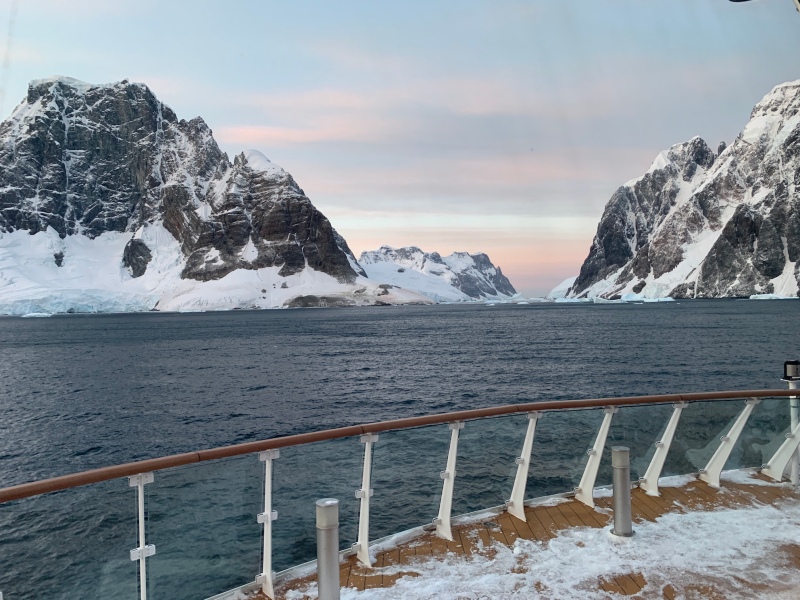
Lemaire Channel. Nearby Port Charcot is our southernmost landing.
Day 7: 21 March, evening: We leave the Peninsula, northward bound. Seven days have passed. Seven. My Covid guard eases. Everyone is well. I feel the shroud of concern slip from my shoulders. We have squeaked through unscathed. We are safe. Surely.
Day 8: 22 March: I sit in the front corner of our lecture theatre as one from our team delivers an Antarctic presentation. From behind and all around me I listen to a dissonance of small dry coughs. I look to Expedition Leader Flo at the very moment she looks to me. Perhaps we both close our eyes in the same ragged breath.
In the early evening our ship’s doctor shares with us that a passenger has just presented with fever. The patient and partner have been moved to the ship’s isolation wing prepared in advance for this unwanted reality.
Day 9: 23 March: Lock down. Our passengers are confined to their cabins where they will remain, heroes, troopers, each and every one of them, for an interminable 19 days. We do not know the cause of the fever. Until proven otherwise we must prepare for Covid while we hope against hope for a better outcome. The cabins are spacious and beautiful, heated bathroom floors, big screen tv’s, nearly all have their own balcony. This I know: no matter how you dress it up, a cage is a cage.
Day 10: 24 March: We are a ship with fever. Borders close to us. We say goodbye to the prospect of Stanley providing us a Cordon Sanitaire from the dock to a plane. We set a course for Montevideo, the capital of tiny Uruguay whose port remains open. We fang northward at 14.6 knots, pushed along by the might of the Falkland Current. Wanderers, Black-browed albatross, small and large seabirds wheel by, soaring in the winds.

Daily temperature testing
Day 11–13: 25–27 March: Our two ship’s doctors don and doff full PPE gear to conduct twice daily temperature checks of every person aboard. More fevers emerge. Some present without fever, just mild symptoms from headache, scratchy cough, diarrhoea, changes in taste and smell, general achiness, to feeling a bit off. One doctor is convinced of Covid. The other has his odds staked on a less insidious ship’s bug. We in the team grow to mistrust our bodies: we fret about a sneeze, a clearing of the throat, a tightening of the chest. In bed at night I check my brow with the back of my hand, convinced it is warm, relieved the next day when the doctor’s thermometer flashes a healthy number. Dr Mauricio has an uncanny habit of leaping unannounced into our office doorway, his thermometer primed. ‘¡Hola, Senoritas!’ He makes us laugh.
We are a unified, harmonious team, kept strong by the remarkable spirit of Florence. We are also supreme at adapting. After all, on any given day in Antarctica, plans change, determined by the vagaries of weather. Regardless of our official shipboard roles, we are willing participants in whatever needs doing.

Meal deliveries set down outside cabin doors
The days of isolation fall into an ongoing pattern of washing hands countless times, donning masks and gloves. These are in short supply and we are compelled to wear this gear for days at a time. We deliver three meals a day to outside cabin doors. I make the wake-up calls, give announcements through the day. Flo speaks at length to the ship at least twice each day. There is no spin. No bullshit. We tell it as it is, even when there is nothing new to say.
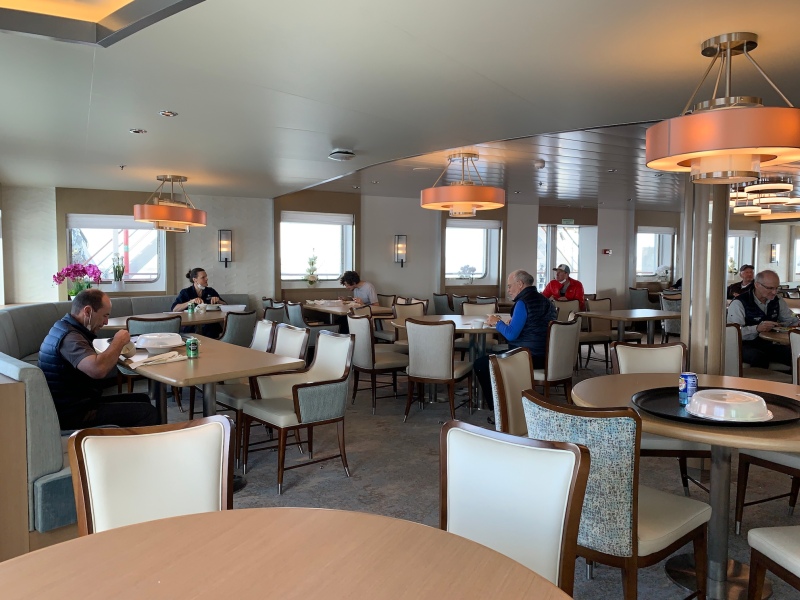
Meals in the dining room
Daily, the team phones each cabin for a catch up, checking how each passenger is faring within themselves. It becomes a very nice way of connecting. We man and woman the reception phone to give the last standing crew receptionist her breaks. We take afternoon cappuccino orders and rotate the tasks between us. Swiss Assistant Expedition Leader Thérèse creates the daily ‘rooster’ as she calls it. We love her Swiss variation and adopt it as the roster’s title. I discover I am a better Zodiac driver than balancing a heavy dinner tray up and down the stairs. The friendly dishwasher in the galley never loses his patience at having to rinse my tray of spills. The dining room is stripped of its finery. We in the team eat our meals one per table, too far apart for easy conversation. Historian Carol likens us to Benedictine monks, alone with our supper in silent reflection.

We publish The Masked Penguin, a simple news sheet the mono printer churns out each morning. We mask up to offer daily broadcasts over the ship’s intercom. Alan our Canadian seabird naturalist enthuses us with new birds outside our cabin windows. Jane our kiwi mountain guide offers cabin workouts. Aussie kayaking guides Daniel and Eamon deliver Q&A sessions, comprising genuine and goofy questions. They read from a selection of passenger haikus: Sunlight glistening / Reflecting through the window / Our thoughts shimmering
Our host of team experts speak about weather and climate. They recount anecdotes from former lives as Antarctic research scientists and field assistants. Dan develops quite a following and we joke that when all this is over he has a second career waiting in radio. The speakers in the ship’s public areas overheat with the spikes of activity and threaten to fail. We adapt our broadcasts.
Day 13: 27–31 March: We arrive at Montevideo on the evening of 27 March. We anchor out in The Roads, 12 nautical miles offshore. This will be our home for the next 14 days. Passengers in portside cabins look down from their balconies at a school of hammerhead sharks cruising by.
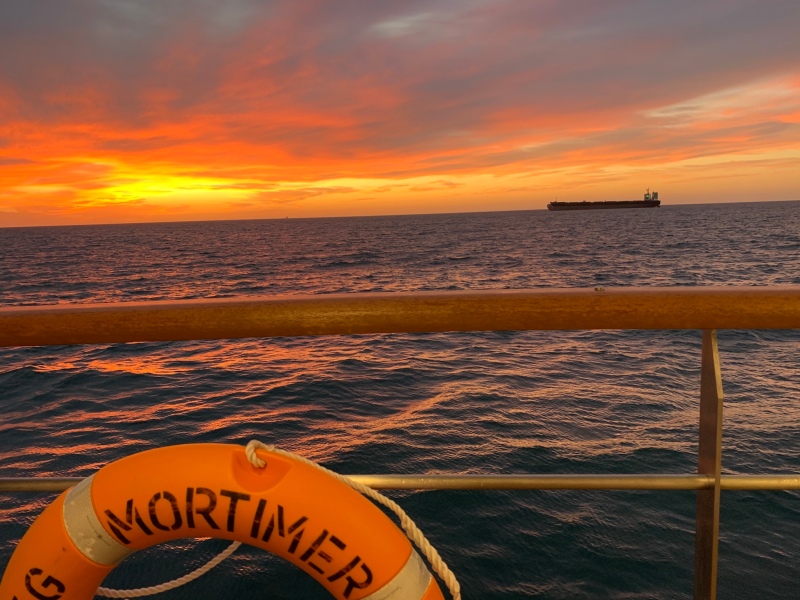
Montevideo sunrise
Uruguay supports us with provisions and medications. When the shallow waters of Rio Del Plata grow turbulent and too stirred with mud to make our own fresh water, a supply vessel tops up our supply. My newly washed hair feels as coarse as straw. ‘Do you think it’s Covid?’ I say to Flo. She checks her own hair. ‘If it is, we both have it.’
We are not permitted to berth at Montevideo until our ship remains fever free for 14 days. With 217 aboard and a rolling infection, the quarantine clock winds back to zero each time a new fever presents. Mountaineer Jane calculates we will be free to berth in approximately two years.
Cargo ships and bulk carriers sit at anchor in The Roads, each waiting their turn to go alongside. Our immediate neighbour is a ship from the Greenpeace fleet. On the other side MS Expedition sits at anchor with only crew aboard. She was destined to leave Ushuaia for Antarctica around the same day as us. Her voyage was suspended, her passengers sent home, the risk to lives deemed too high. I picture the crew looking across to us with empathy, their decision validated.
Day 17: 31 March: I will look back on this day as the moment when Covid morphed into a sinister new being, capable of indiscriminate assault. A male passenger with fever develops acute respiratory problems and is medevaced to Montevideo’s Hospital Britanico. It will be the first of many mercy visits from Uruguay’s SAR vessel which motors out in rough sea conditions to collect unwell passengers requiring hospitalisation. We are so very grateful for Uruguay’s medical support. With both vessels side by side, heaving in the swell, our first patient, dressed in full PPE gear, steps across the abyss from one vessel to the other, the SAR crew gripping the railing with one hand, waiting to catch him with the other, the oxygen tank still attached, thrown across in his wake. I cannot decide who is the braver: our passenger or that Uruguayan crew.

Dr Mauricio Usme
Day 18: April Fool’s Day: Through this entire time our ship’s doctor Mauricio, the undeniable hero of the voyage, has taken the front line and with it the very great risk of contracting the virus. His strategy is to protect our second doctor should he, Mauricio, fall ill. Dr Jeff is wakened in the night. Mauricio is running a high fever and has isolated himself to his cabin. Dr Jeff’s worst nightmare has arrived. He attends to Mauricio then assumes sole medical responsibility.
We wait for test results to come back from the hospital where our first patient is now in a critical condition in ICU. I wish I could hug his partner who remains onboard alone in her cabin. A female passenger in cabin isolation takes a turn for the worse. More from our ship’s crew succumb to fever. Two by two, crew and cabin mate retreat to isolation.
The test results arrive. That it reads Covid should be no surprise and yet we hang our heads. We, this ship, this blighted voyage, we are the April Fool.
Florence, Captain and I hold an emergency meeting. With the current trajectory, we calculate the obvious: already there are not enough stewards to deliver meals; we in the team have been working to fill the growing shortfall. Soon there will be insufficient crew to cook and prepare meals, to maintain a sustainable level of hygiene around the ship, to fulfil the vessel’s technical requirements, to even man the bridge. Captain transmits the message to the Uruguayan Coastguard: We have reached a humanitarian crisis. We are in need of urgent help.
Day 19: 2 April: Wild seas prevent the rescue vessel from motoring out to retrieve unwell patients.
Day 20: 3 April: The wind is still strong, the ocean still rough. The rescue vessel tracks back and forth to collect two ill crew members and another passenger. In the evening a vessel brings a team of young Uruguayan medics who board the ship. I wonder if they might be medical graduates or even students who have volunteered for the task. They work seven hours straight, half the team going from cabin to cabin to test passengers with a PCR nasal swab, the other half working in the mudroom to test each of the crew and our team. As the ship heaves in the swell they perform each swab. It is midnight before I am close to being tested. I watch crewmen leave the testing bench, pinching the bridge of their nose, shaking off the sensory assault of having a swivel stick poked far up each nostril. The medic speaks in gentle, broken English: ‘Do you mind if I take a moment? Fresh air.’ She gestures to a side door. I recognise seasickness behind that face shield and mask. Within minutes she returns to her post to perform my test. I leave the mudroom gripping my nose.
Day 21: 4 April: Dr Jeff falls to the virus. A Uruguayan doctor comes aboard to stay and assist. He works hard. He speaks no English. Naturalist Roger helps to translate.
Day 22: 5 April: A Uruguayan medical team comes aboard and spends most of the day doing medical check-ups for everyone onboard: temperatures, blood pressure, blood oxygen, questions about symptoms. We are told informally that a high proportion of the ship’s company has tested positive for Covid. We are not given numbers. Test analysis is still ongoing at the lab. The team gives some of us our individual test result.
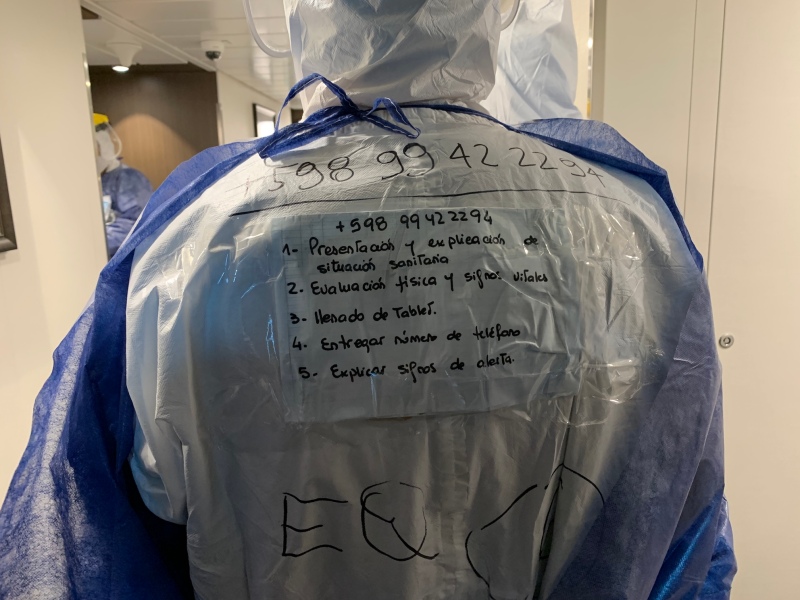
The Uruguayan medical team show us the number to call should we present with symptoms
Day 23: 6 April: The full test results from the PCR nasal testing are emailed to the ship. Results are shared amongst the crew’s senior managers though not with our Expedition Leader. Printouts showing each person’s results are left on the bar and in the public lounge. Our mountain guide learns his results from the Hotel Manager. What of medical confidentiality? We learn that sixty percent onboard have tested positive to Covid. Fear sets in amongst those in the crew who test negative. Our passengers, safe inside their cabins, remain oblivious to the shift in mood aboard the ship.
Days 24–25: 7–8 April: Our days grind on, the company working around the clock to negotiate a medical charter from Montevideo to Australia, another to the USA and on to the UK. Throughout these days, each new charter possibility, each new negotiation with Consulates and Ministers, has been dashed. We know our company is scouring every avenue to get our passengers and team home, but this rollercoaster is a cycle of hope and despair. Today we are told, cautiously, that things are getting close, that we are at last on the verge of a very real outcome. Contracts with charterers, agreements with governments, are being drawn up, ready for signing. Each morning we print out copies of a new daily update from head office and post it outside cabin doors. I remove the company logo from all but the front page to cut down pages. We are down to our last box of paper.
Day 26: 9 April: Arrangements are firmed up for a medical charter flight to Australia. The kiwis will join the fight then transfer to a small charter direct from Melbourne to Auckland. Tomorrow at 0500 a specially fitted Airbus A340 will arrive in Montevideo from Portugal. We are told that the charter specialist has been operating for 15 years, repatriating passengers and transporting vital medical and protective equipment around the world. It feels like a miracle in the making. A gripping ride arrowing to the sky. I dare not set my hopes too high.
Day 27: 10 April: I wake from a dream that we are stopped on the road by angry protestors. I arrive at the ship’s office to learn that the charter plane has touched down on schedule. It is here, really here, waiting for us at Montevideo’s Carrasco International Airport. Uruguay has agreed to provide the 97 Australian and 15 New Zealand passengers and team members a Humanitarian Corridor from the dock to the airport. I have butterflies in my stomach that flutter stupidly for the entire day. Let it happen.
As I announce the day’s plans and details for the flight, the moment grows bittersweet. Our internationals. We are leaving twelve passengers and eight from our team behind. Their arrangements are still to be finalised. Worse, the atmosphere onboard has escalated into one of volatility. While Florence makes plans to protect her remaining team, arranging their move to adjacent passenger cabins with adjoining balconies, I inform the Australians and New Zealanders of our flight arrangements. We may bring only carry bags. We must leave our check-in luggage behind. No exceptions. No baggage handler will handle our contaminated luggage. Yes, we may bring scissors, sharp objects, no limit on liquids, so long as we alone can carry our belongings to the plane.
I believe all of us would have walked onto that plane with nothing.
The day is hectic. Late afternoon arrives before I focus my sights out the windows. The city of Montevideo shimmers silver, the skyline no longer a distant haze but a distinct line of buildings new and old. ‘Are we moving?’ I state the obvious. Normally I would be on the Bridge, looking forward, but the Bridge has been closed to all but ship’s officers since the first fever.
As we approach Montevideo Harbour, people are lined along the shoreline. They stand on the sea wall. It takes me a moment to register the full meaning. They are waving. They cheer and hoot. They look so happy to see us. They are not here to protest or turn us away. I step out onto the open back deck to wave back. To cry. Uruguay: you are a small country with a big heart. Locals post photos of our arrival to the company’s Facebook page. They text dozens of messages. ‘You will be home soon. You will be safe.’ ‘Uruguay loves you.’ ‘We welcome you, dear friends.’ They are humanity as its most generous and inspiring.
At 2130 we call our first passengers down. It feels strange to see these faces after 19 days. As if we are meeting for a first date, unsure of how to be with one another in this new, socially distanced world. Each person is donned in gloves and an N95 mask. Buses pull up one by one. Passengers are counted off as they make their way down the gangway. All but two of our passengers from hospital will travel by ambulance directly to the plane. Our two who remain in ICU are deemed not yet strong enough to travel. Their partners are transported from the ship to the hospital to remain behind and be by their sides.
The 45-minute journey from the dock to the airport is a spectacle, even from the inside of the bus. We are a kilometre-long cavalcade of buses, security vehicles and ambulances. Later I will watch images of the event on Uruguayan television news. For now, coloured lights flash. Sirens blare. On every corner of every street a parked police car or motorbike halts local traffic. It is difficult to see through the darkened windows of the bus. I make out people on sidewalks, standing on balconies. Arms are waving. Flags fluttering.

HiFly Airbus A340 charter plane at Montevideo airport
This is no regular airport check-in. Each bus in turn moves out onto the tarmac beneath the wing of the enormous Airbus. I have never seen such an aircraft from this perspective or understood its full height. In slow orderly procession we make our way up one of two very steep outdoor steps and directly into the plane.
The cabin crew are dressed in white hazmat suits, hoods, goggles, masks and gloves. In my section the attendants are nearly all men, Portugese names written on their suits in black texta. They greet us warmly, as if we were any regular traveller returning home from holidays. Areas of the cabin are cordoned off with plastic sheeting to create medical bays. It resembles a scene from Breaking Bad, akin to a makeshift meth lab. Doctors and nurses are onboard to attend to our hospital patients and any traveller needing assistance during the 16-hour nonstop flight. I have been tasked with handing the ship’s ‘Fit to Fly’ document to the pilot. The plane, I have been told, cannot leave without it. The signed, stamped document lists each person’s health status and body temperature, final recordings taken onboard that afternoon. The cabin attendant I talk to seems puzzled by the documents. He takes the envelope and sets it aside. I go to urge him how vital it is that these papers reach the pilot. I stop myself, take my first steps back from my shipboard role. The crew, now, are in charge. Attendants show us to our seats and sort out mix ups, they soothe anxieties, help stow bags that no longer fit the crammed overhead bins.
There is no dilly dallying. We push back the moment the doors close. I do not register a safety demonstration though perhaps sensory overload is at play. At 0145, right on schedule, we move into position and in a mighty surge and rumble we barrel down the runway, arc up into the sky. We are away. Above the city. Tracking west across the night.
I wake at predawn as we cross the beautiful New Zealand alps. They feel as comforting as home.

Crossing the Australian coast
When I wake the next time the wing of the plane is enveloped by apricot sunrise. We cross the Australian coast. The pilot’s voice comes over the loudspeaker to thank us for choosing his airline to travel with. He hopes to see us again. Under better circumstances, he adds.
At 0655, Easter Sunday morning, we touch down on the tarmac at Melbourne.
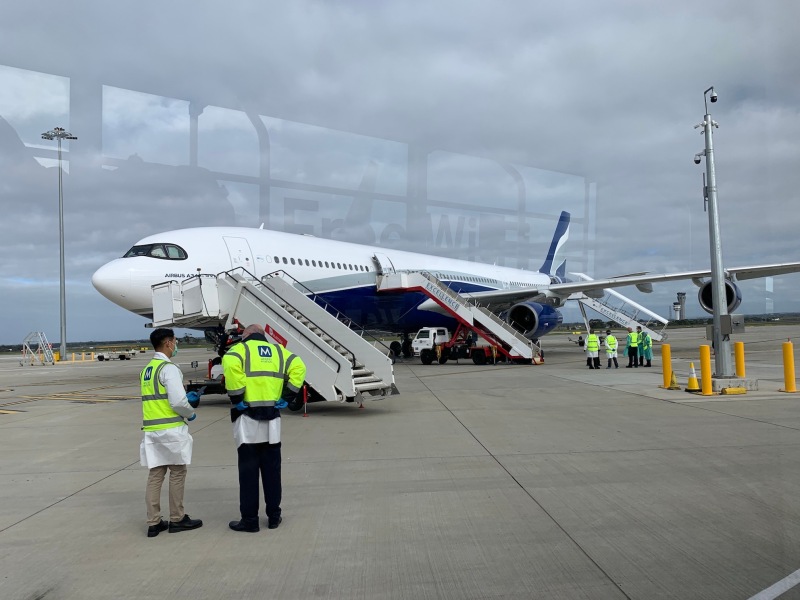
The Airbus on the tarmac in Melbourne
AFTER
a league of tragedy
On 15 April 2020 our internationals take their turn on a Boeing 737 medical charter to Miami, USA. From there follows an elaborate series of smaller charter flights which, miraculously, thanks to the company’s detailed arranging, all line up. The exception is our Canadian naturalist whose final charter is redirected mid-flight due to a refusal to the plane to land in Canada. He is met by ground ambulance and driven the final hours to the Canadian border. The ambulance doors open to a line of uniformed border guards wearing surgical masks and guns in their belt holsters. He asks them, ‘Are you here to shoot me if I make a break for it?’ A moment’s silence before they break into a grin. ‘Welcome back to Canada.’
The 737 continues on to the UK, to ground ambulance shuttles, to yet more charter flights onward to Europe, all the 19 delivered home.
Partway through my Melbourne quarantine we receive news from the ship that Ronnie, a Philippine crewman, has passed away from Covid. Since being admitted to ICU in Montevideo, his health status has remained confidential. The news leaves us numb with shock. The voyage plunges to a league of tragedy.
As I sit here in Hobart quarantine, the ship remains at anchor off Montevideo. Two of our passengers remain ashore in Hospital Britanico, supported by their partners. Our Zodiac Manager is the last of our expedition team still aboard, our company working through the challenges to repatriate him home to Russia.
Eighty-four crew members from numerous countries are still on board. Some have been separated from their families for close to eight months, having signed on in September 2019, a time before Covid-19, when the newly built ship departed its Chinese shipyard.
After a stint in hospital Dr Mauricio is back onboard, thankfully fit and well. He remains a strident voice in appealing to the USA-based company which employs the crew, and to the Uruguayan government, to repatriate the crew to their homes.
I would not wish this blighted voyage on anyone. Yet even owning my premonitory fears leading up to the voyage, I do not regret being part of it. To witness the courage and stamina of our passengers, and to work with a remarkable team of resilient, capable, rock-solid colleagues who each laid their life on the line, was a privilege. Equally, it was a joy to work side by side with an exceptional expedition leader who recognised and drew upon every person’s strengths. I like to think we shared fortitude, clear thinking, compassion and caring, qualities that help get us through.

Touch down in Hobart, Tasmania
Photos and text ©Robyn Mundy, 2020
News articles relating to the voyage and current situation aboard can be sourced from the following hyperlinks:
3 May 2020:
21 April 2020:
21 April 2020:
Dr Alan Burger (shipboard naturalist) website and blog:
Like this:
Like Loading...
